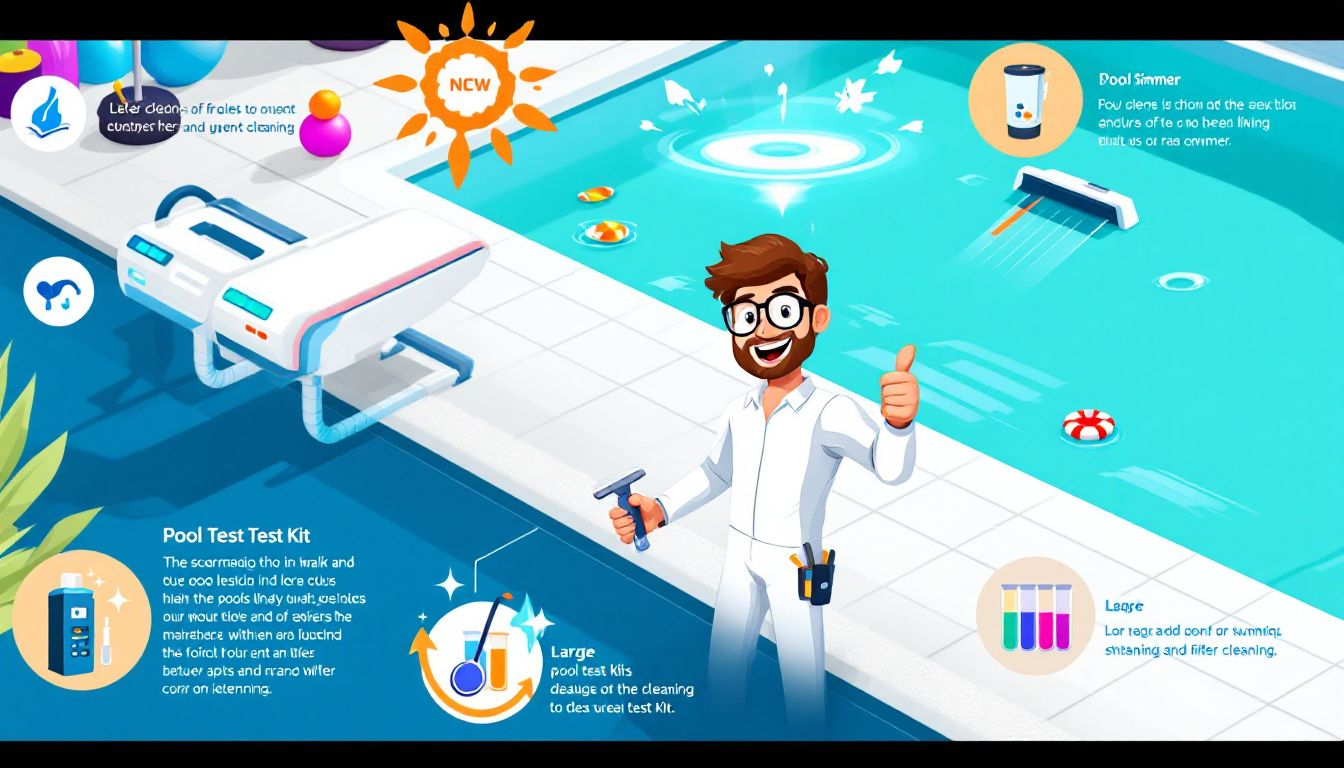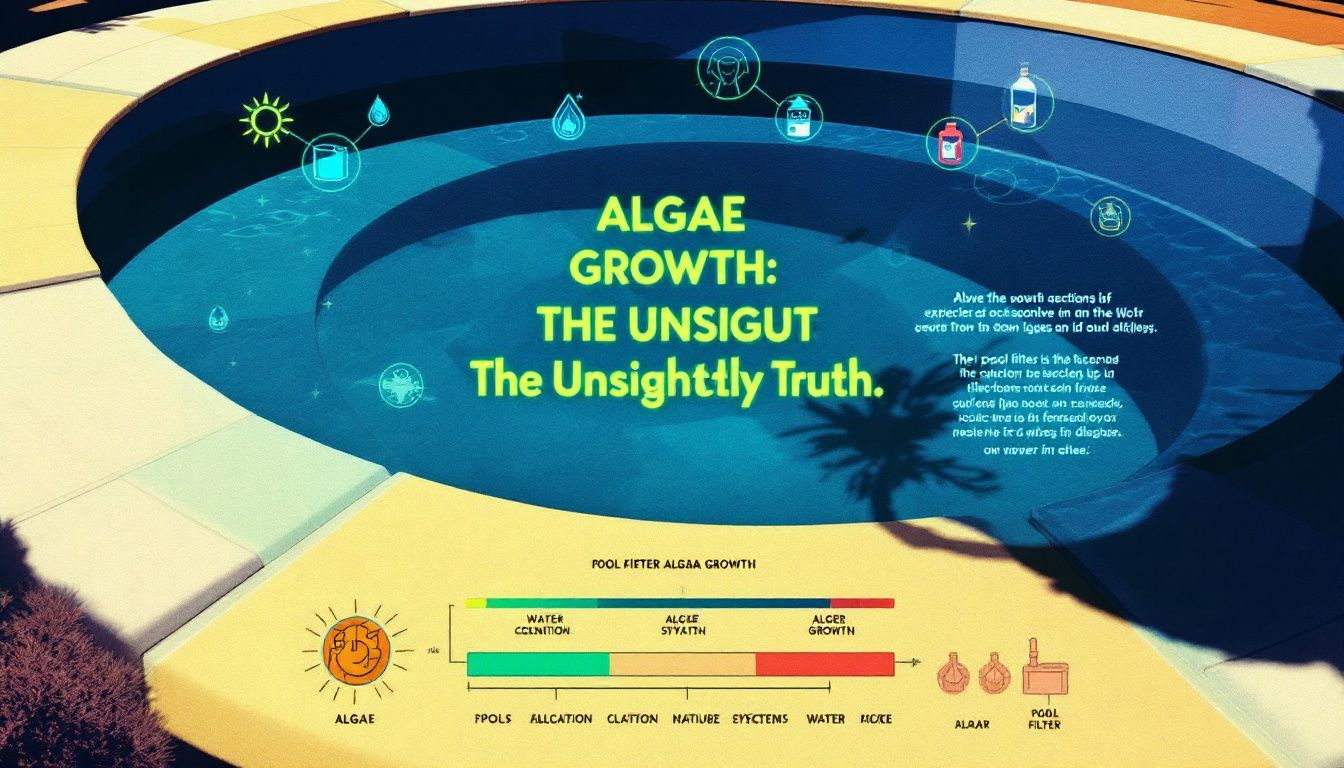
Best Year Round Maintenance Practices for Fiberglass Swimming Pools
Key Takeaways
Regular pool cleaning, including daily skimming, weekly vacuuming, and brushing walls, is essential for keeping a fiberglass pool healthy and inviting.
Maintaining proper water chemistry—including pH, chlorine, alkalinity, and calcium hardness—is crucial for swimmer safety and prolonging the pool’s life.
Routine equipment maintenance and seasonal adjustments help ensure your pool operates efficiently and stays in good condition throughout the year.
Regular Pool Cleaning

Regular pool cleaning is the foundation of maintaining a fiberglass pool. Keeping the pool area free from debris and contaminants ensures a healthy swimming environment. Imagine stepping into a pool with clear, inviting water every day. Achieving this requires consistent cleaning efforts that prevent mineral deposits and algae growth, which can affect water clarity and pool health.
Daily skimming, weekly vacuuming, and brushing the pool walls are crucial components of a thorough cleaning routine. These practices not only keep the pool looking great but also help in maintaining the structural integrity of the pool. Incorporating these tasks into your regular fiberglass pool maintenance schedule keeps your fiberglass pool in pristine condition year-round.
Next, we explore each cleaning task in detail, offering instructions and tips for an effective and efficient routine.
Skimming Daily
Daily skimming is a simple yet effective way to keep your pool clean. Using a skimmer net and telescopic pole, you can easily remove floating debris such as leaves, bugs, and other unwanted materials from the pool’s surface. This prevents the debris from sinking and clogging the filter, ensuring better water circulation and filtration.
Regular skimming keeps your pool inviting and reduces the need for intensive cleaning tasks later on.
Weekly Vacuuming
To ensure a thorough cleaning, vacuuming the pool weekly is necessary. A pool vacuum is particularly effective in removing dirt and debris from the pool floor and walls. Robotic pool cleaners can be a great investment, as they efficiently collect dirt from the pool’s corners and edges, making the job easier and ensuring that no spot is missed.
Weekly vacuuming is part of basic maintenance, helping reduce the buildup of contaminants.
Brushing the Pool Walls
Brushing the pool walls is another important step in maintaining your fiberglass pool. Using a soft brush, you can remove dirt and algae that may adhere to the pool’s surface without damaging the gelcoat. Regular brushing helps prevent algae growth and keeps the pool walls looking clean and smooth.
This practice maintains the swimming pool surface aesthetics and ensures a healthy swimming pools environment.
Maintaining Water Chemistry

Proper water chemistry is crucial for the safety and longevity of your fiberglass pool. Balanced water chemistry ensures the safety and comfort of swimmers while protecting the pool’s surface from damage. Regular testing and adjustments are necessary to keep the water in optimal condition. Maintaining the right chemical balance prevents issues like cloudy water, algae growth, and scaling.
Testing the water at least weekly is a good practice to ensure that all chemical levels are within the recommended ranges. During the swimming season, more frequent testing may be required to account for changes in water chemistry due to factors like bather load and sunlight exposure. Monitoring water chemistry closely allows for timely adjustments, avoiding potential problems.
Next, we’ll cover key aspects of water chemistry management: pH levels, chlorine levels, and alkalinity and calcium hardness. Each of these factors plays a crucial role in maintaining water quality and ensuring a safe swimming environment.
pH Levels
Correct pH levels are crucial for effective chlorine use and swimmer comfort. The ideal pH range for fiberglass pools is between 7.4 and 7.6. Regularly testing the pH levels and making necessary adjustments will help prevent issues such as skin irritation and chlorine inefficiency.
Maintaining optimal pH levels keeps the pool water clear and comfortable.
Chlorine Levels
Chlorine is crucial for killing bacteria and preventing the growth of microorganisms in the pool water. For fiberglass pools, maintaining chlorine levels between 1.0 and 3.0 ppm is recommended. Factors such as temperature, bather load, and sunlight can affect chlorine levels, so it’s important to test the water regularly and adjust the chlorine levels as needed.
Managing chlorine levels properly maintains water clarity and ensures safety.
Alkalinity and Calcium Hardness
Alkalinity and calcium hardness are also important aspects of water chemistry. For fiberglass pools, the recommended alkalinity range is 80-120 ppm, and calcium hardness should be maintained between 200-400 ppm. Proper alkalinity helps stabilize pH levels and prevents rapid fluctuations that can lead to scaling or corrosion.
Proper alkalinity and calcium hardness levels ensure the pool’s health and functionality.
Equipment Maintenance

Regular maintenance of pool equipment ensures efficient operation. Proper care of the pool’s equipment can prevent costly repairs and extend the lifespan of the components. Neglecting equipment maintenance can lead to inefficiencies and performance issues that can affect the overall functionality of the pool.
Routine inspections and maintenance practices play a significant role in identifying potential issues early and addressing them before they become severe. Regular maintenance routines can significantly impact the longevity of the equipment, ensuring that your pool remains in top working condition.
Next, we’ll cover key aspects of equipment maintenance: filter maintenance, pump and heater checks, and plumbing and valve inspections. Each task is essential for ensuring the efficient operation of your pool equipment.
Filter Maintenance
The pool filter has the crucial role of removing debris from the water. It also helps in maintaining good water quality by eliminating impurities. Regular inspections for signs of damage and cleaning or backwashing the filter weekly are essential for its optimal performance.
Replacing filter media when necessary keeps the filtration system functioning efficiently.
Pump and Heater Check
Regular inspections of the pump and heater identify leaks, unusual noises, and ensure proper functioning. Clearing pump strainers regularly and lubricating the pump’s o-rings as needed are important maintenance tasks.
If your pool is surrounded by trees, checking and clearing the pump basket every few days can prevent debris accumulation and ensure efficient operation.
Plumbing and Valves Inspection
Regular plumbing and valve inspections prevent leaks and protect your pool investment. Early identification of leaks and damage can reduce water loss and utility bills, preventing costly repairs to the pool equipment.
Seasonal Adjustments

Seasonal adjustments are essential for ensuring the longevity and functionality of inground fiberglass pools. Proper care during different seasons can help maintain the pool’s condition and prevent damage. Heating efficiency is particularly important during colder months to keep the pool usable and comfortable.
Regular visual inspections for cracks and other issues should be part of the maintenance routine to address any problems early on. Adjusting the maintenance practices according to the season can help you enjoy your pool year-round without major issues.
Next, we’ll discuss key seasonal adjustments: winterizing your pool, opening for swim season, and offseason care.
Winterizing Your Pool
Winterizing your fiberglass pool prevents damage from freezing temperatures. Before winterizing the pool, lower the water level below the skimmer. Also, ensure the return lines are emptied. Use a quality winter cover to keep debris out, prevent algae growth, and protect the pool from harsh weather.
Ensure the winter cover is fastened properly to prevent it from blowing away.
Opening for Swim Season
Balancing water chemistry is crucial when opening the pool for swim season. Ensure to run the filter and adjust chemical levels to maintain optimal conditions.
Many homeowners typically open their pools around Memorial Day weekend when the temperature is consistently above 70 degrees.
Offseason Care
Regular water level checks during the offseason ensure the pool remains protected. Periodic operation of the filtration system is necessary to maintain overall pool hygiene during off-seasons.
Regularly cleaning the pool cover can help maintain its effectiveness and extend its lifespan.
Addressing Stains and Algae

Promptly addressing stains and algae is essential to maintain the pristine appearance of a fiberglass pool. Regular cleaning and proper maintenance are key methods for preventing staining and algae growth. Maintaining proper water chemistry can also prevent most stains on the pool’s surface.
If algae appear in your pool, treat it with algaecides and brush the affected areas to maintain cleanliness. For persistent algae blooms, shock the pool with higher chlorine levels to eliminate the problem.
Next, we’ll discuss identifying and removing stains, as well as algae prevention methods.
Stain Identification and Removal
Common types of stains found in pools include organic stains, metal stains, and rust stains. Using a commercial stain identification kit can help determine the type of stain present.
Rust stains can be treated by scrubbing with chlorine tablets or Vitamin C tablets, which help dissolve the stain. Specialized stain removers may be needed for certain stains, while minor stains can be removed with a cloth or sponge and a gentle cleaning agent.
Algae Prevention
Preventing algae growth maintains water quality. Good water circulation and maintaining proper chemical balance are key factors in algae prevention. Regularly shocking the pool using the SLAM method and using algaecides can effectively treat algae growth.
Proper water circulation prevents stagnant areas where algae can thrive.
Safety and Aesthetics
A safe pool environment is crucial for the well-being of all swimmers. Supervision of children and ensuring that safety equipment is readily available are vital steps in maintaining pool safety. Proper maintenance not only enhances safety but also improves the aesthetic appeal of the pool.
Installing safety features such as fencing and safety equipment can prevent unauthorized access and ensure the pool is safe for everyone. Enhancing the pool’s aesthetic appeal through regular maintenance and cleaning practices creates an inviting environment for all to enjoy.
Next, we’ll discuss installing safety features and tips for enhancing the pool’s aesthetic appeal.
Installing Safety Features
Installing safety features around the pool prevents unauthorized access by children. A fence that is at least four feet high with a self-closing and self-latching gate is recommended. The pool fence should comply with local safety regulations and guidelines.
Keeping safety equipment like life rings and shepherd’s hooks within reach enhances emergency preparedness. Automatic pool covers also enhance safety by preventing unauthorized access and keeping debris out.
Enhancing Aesthetic Appeal
Maintaining the aesthetic appeal of your pool involves regular cleaning and upkeep. Use a tile cleaner and a soft brush to clean the tiles around the waterline and prevent calcium deposits and mineral buildup. Incorporating regular maintenance practices helps keep the pool looking inviting and vibrant.
Ensuring that the pool maintenance is clean and well-maintained enhances its overall visual impact and provides year-round enjoyment.
Summary
In summary, maintaining a fiberglass swimming pool year-round involves regular cleaning, balancing water chemistry, and diligent equipment maintenance. Seasonal adjustments and prompt addressing of stains and algae ensure the pool remains in pristine condition. By following these best practices, you can enjoy a clean, safe, and aesthetically pleasing pool all year round. Implement these maintenance routines, and your pool will continue to be a source of joy and relaxation for many years to come.
Frequently Asked Questions
How often should I skim my fiberglass pool?
You should skim your fiberglass pool daily to keep it clean and prevent debris from sinking and clogging the filter. Staying on top of this will make maintenance much easier!
What are the optimal pH levels for a fiberglass pool?
For a fiberglass pool, you want to maintain your pH levels between 7.4 and 7.6 for the best balance and performance. Keeping it in this range will help protect the pool's surface and ensure a comfortable swim.
How can I prevent algae growth in my pool?
To prevent algae growth in your pool, keep the chemical balance right and ensure good water circulation. Don't forget to use algaecides when necessary for extra protection!
What is the recommended chlorine level for fiberglass pools?
For fiberglass pools, aim for a chlorine level between 1.0 and 3.0 ppm to keep your water safe and clean. It's that simple!
How do I winterize my fiberglass pool?
To winterize your fiberglass pool, lower the water level below the skimmer, use a quality winter cover, and add winterizing chemicals to prevent freezing. It's a straightforward process that helps protect your pool during the colder months.

